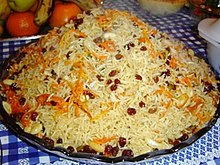Kabuli pulao
 Qabeli palaw | |
| Alternative names | Kabuli Pulao, Uzbek palaw, Bukhari rice |
|---|---|
| Type | Rice |
| Course | Lunch, dinner |
| Place of origin | Afghanistan |
| Region or state | Central Asia |
| Associated cuisine | Afghan cuisine |
| Created by | Afghans |
| Serving temperature | Hot |
| Main ingredients | Steamed rice, raisins, carrots, and lamb or veal |
Qabeli palaw (Dari: قابلی پلو, pronounced [qäːbeliː päˈläw], also transcribed as Kabuli pulao, Pashto: قابلی پلاو) is a variety of pilaf made in Afghanistan.
The core ingredients are steamed rice mixed with caramelized carrots and dry raisins as well as marinated lamb meat. Qabeli palaw is commonly garnished with almonds and pistachios. Saffron may be added to either the rice, the sauce or the garnishes.[1][2] Varieties of Kabuli palaw have spread from Afghanistan to different parts of Western and Central Asia and Pakistan.[3]
Even though frequently misnamed "Kabuli pulao", the dish did not originate in Kabul. The more likely place of origin is Northern Afghanistan, specifically the border region with Uzbekistan.[4][5] A variation of Qabeli palaw made by Uzbeks within Afghanistan is also referred to Uzbaki palaw. The Uzbaki version differs from traditional Afghan palaw preparation in that it doesn't first soak, then parboil, then steam the rice until fluffy, but rather just boils the rice until all liquid has been absorbed.[6]
To add to the naming confusion Afghan émigrés in Dubai and Istanbul marketed this dish as Bukhari rice, again hinting at a possible origin within the Afghanistan and Uzbekistan border region. As bukhari rice dishes have gained popularity in the Gulf region, those local preparations often differ greatly from authentic Qabeli palaw.[7][8]
Spelling
[edit]A common source of misspelling is the romanization of palaw as "pulao".[9] Palaw dishes form a specific and longstanding tradition of rice preparation in Afghanistan, likely dating back as far as Bactrian times.[10] In terms of etymology palaw constitutes the classical pronunciation of Persian پلاو [pʰaˈlaw] wherein the sharp diphthong "aw" or /äw/ is preserved. This diphthong should be pronounced closely akin to the English word cow /kaʊ/ and is therefore incorrectly romanized with the spelling "pulao".[11]
Pulao (Hindustani: [pəlaʊ]) instead refers to a distinct subgroup of pilaf as made on the Indian subcontinent[12] and reflects a differing pronunciation as shaped by local language.[13]
Serving
[edit]Qabeli palaw is considered a festive and important dish due to the emphasis on quality of the ingredients, as well as being a widely known dish of Afghan cuisine. The dish may be served as a main course, accompanied by traditional side dishes or prepared as part of a banquet.[14]
See also
[edit]References
[edit]- ^ Coussidis, Harris (29 April 2019). "Kabuli Pulao: The national dish of Afghanistan". FMT. FMT Media. Retrieved 28 May 2023.
- ^ Roustaei, Omid (8 September 2021). "Afghan rice and carrot pilaf with lamb". The Caspian Chef. Retrieved 28 May 2023.
- ^ Marsden, Magnus (April 2021). "Commerce, Cuisine and Cultural Exchange in Afghanistan, West Asia and Beyond" (PDF). Afghanistan. 4 (1). Edinburgh University Press: 66. doi:10.3366/afg.2021.0067. S2CID 234975829.
- ^ Marsden, Magnus (April 2021). "Commerce, Cuisine and Cultural Exchange in Afghanistan, West Asia and Beyond" (PDF). Afghanistan. 4 (1). Edinburgh University Press: 6 5. doi:10.3366/afg.2021.0067. S2CID 234975829.
- ^ Seddiq, Mirriam (5 September 2021). "Kabuli Pulao Recipe". Afghan Cooks. Retrieved 30 May 2023.
- ^ Saberi, Helen (2000). Afghan Food & Cookery (7 ed.). New York: Hippocrene Books, Inc. p. 134.
- ^ Marsden, Magnus (April 2021). "Commerce, Cuisine and Cultural Exchange in Afghanistan, West Asia and Beyond". Afghanistan. 4 (1). Edinburgh University Press: 66. doi:10.3366/afg.2021.0067. S2CID 234975829. Retrieved 28 May 2023.
If Saudi publics as well as those visiting the country for trade, pilgrimage and labour, consumed heaps of Bukhari rice in Afghan-run eateries, diners from Afghanistan would take up their positions in more modest cafes serving authentic northern Afghan dishes accordingly: Qabili palaw Uzbeki (Uzbek-style rice with meat), chaynaki (meet cooked with chickpeas in a teapot), seekh kebab (meat grilled on skewers), and kaala pacha (stewed cows feet with black pepper). Such eateries are mostly located in parts of Saudi cities that are and have been for decades home to sizeable and long-standing communities of Central Asian émigrés and northern Afghans, collectively referred to as the 'Bukharis.'
- ^ Salah, Maha (27 March 2020). "Bukhari Rice and Chicken". Middle East Monitor. Ardi Associates Ltd. Retrieved 28 May 2023.
- ^ Miller, Corey (2012). "VARIATION IN PERSIAN VOWEL SYSTEMS" (PDF). Orientalia Suecana. 59 (1): 165.
The diphthongs aj and aw are preserved in Dari, e.g. 'find' /pajdā/, 'rice' /tʃalaw/
- ^ Nabhan, Gary Paul (2014). Cumin, Camels, and Caravans: A Spice Odyssey. University of California Press. ISBN 9780520267206.
- ^ "Persian romanization table" (PDF). Library of Congress. p. 3. Retrieved 30 May 2023.
The diphthong romanized aw. فردوسی Firdawsi
- ^ "How to Make Perfect Pilaf: A Guide for Beginners". Retrieved 30 May 2023.
- ^ Vishal, Anoothi. "What is The Difference Between Pulao (Pilaf) and Biryani?". NDTV Food. NDTV Convergence. Retrieved 30 May 2023.
- ^ Ayubi, Durkhanai (25 June 2015). "Parwana Afghan Kitchen's Kabuli palaw". Gourmet Traveller. ARE MEDIA PTY LIMITED. Retrieved 28 May 2023.
External links
[edit]- Qabili Palao – Margarita's International Recipes
